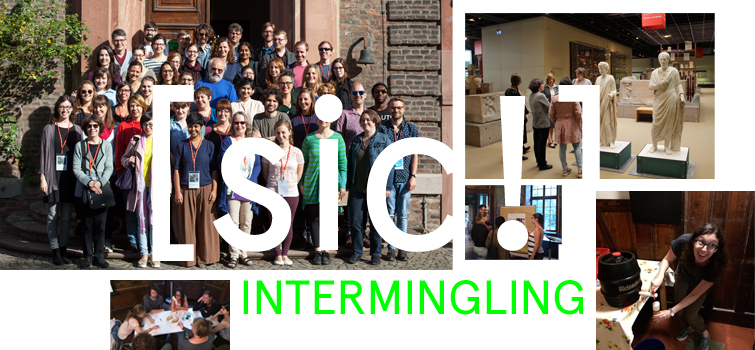2015

Summer Institute Cologne 2015
Intermingling
When Lévi-Strauss distinguished the bricoleur and the scientist by their differing attitude towards taxonomy, order, and clarity, he implicitly called for the ideal of tinkering – working with found materials, accepting the lack of homogeneity, the heterogeneity of material and concepts, and the visible seams and fragments in our argumentation. [sic!] 2015 focuses on "Intermingling" – this ever-happening but rarely mentioned phenomenon – with respect to our materials but also to our concepts and methods. With "Intermingling," [sic!] 2015 proposes a term which is similar to concepts of interculturalism, intermediality, hybridity, and interstices yet also different from them. "Intermingling" is not meant as a new concept, rather it shall be used as a tool by scholars and students from diverse fields to join a dialogue about patchworks, differences, heterogeneity, influences, transfer, and 'odd' knowledge.
[Seminars]
Seminar I [Classics]
Anja Bettenworth (University of Cologne), Ann C. Gunter (Northwestern University)
Intermingling describes the manifold ways in which the past shapes the present, and the present shapes the past. How do institutions such as museums, along with other created contexts such as websites, national monuments, and sites developed as tourist destinations, shape and construct our notions of the past? How are these institutions enmeshed with broader cultural and political agendas regarding cultural identity and otherness, the formation of artistic canons, and even the concept of ancient art and literature?
We approach the construction of ancient Mediterranean culture and especially the art and literature of Classical antiquity through modes of its reception over the past two centuries, seeking to understand the development of modern scholarship on classical antiquity, the intersection of institutional and scholarly agendas, and the intersection of scholarship and popular culture. Topics examined include the historical development of modern displays devoted to ancient civilizations in public and private museums, notions of authenticity and identity, issues of cultural heritage and patrimony, virtual exhibitions and museums, the role of archaeology in creating, negotiating and elaborating national agendas, and the presentation of antiquity in popular culture, including cinema and theme parks. This seminar will draw on the rich institutional resources of Cologne and its vicinity.
Seminar II [Early Modern]
Kasey Evans (Northwestern University), Peter W. Marx (University of Cologne)
Ut pictura poesis: as in painting, so in poetry. This Latin axiom, most often traced to Horace’s Ars Poetica, served as an interdisciplinary ideal for much of early modern humanistic culture. Poets strove for the vividness and immediacy using techniques of enargeia and ekphrasis: both strategies of describing and evoking a visual image on the page and in the mind of the reader. And for visual artists, poetry provided a model for the imaginative and vatic breadth that allows the poet to produce a "golden" world that outshines the merely "brazen" mimeticism of the historian (Defense of Poesy). From his post-Renaissance vantage, on the other hand, Enlightenment philosopher Gotthold Lessing described a fundamental temporal distinction between the two arts. The diegetical art of poetry expands in time, Lessing explained, while painting is a synchronic art that expands in space. Poetry can only be experienced narratively, while painting can be apprehended immediately in its totality (Laocöon).
Immediacy, historicity, diachrony, synchrony: from the pre-modern classical rhetoricians who inspired early modern humanists to the Enlightenment critics who followed them, critics and theorists express the convergences and divergences of literary and artistic production in temporal terms. This seminar will investigate the "intermingling" of poetry and painting with particular attention to temporality, exploring the complex territory that unfolds between Horace’s assertions of likeness and Lessing’s absolute distinction. Special attention might be paid to hybrid artistic ensembles in which texts and images co-exist: these are not only emblems, illustrated books and prints subscribed with poetic inventions. The early modern period has developed various art forms, mostly in religious contexts, that integrate visual and textual elements.
Seminar III [Theatre]
Tracy C. Davis (Northwestern University), Sascha Förster (University of Cologne), Sofie Taubert (University of Cologne)
In theatre intermingling can refer to the phenomenological co-existence of reality and potentiality: the "real" is a proximate claim (to time, space, and experience) symptomatically mixed with "fiction" as potentiality. Intermingling is also a way to describe the simultaneity of aesthetic and receptive conditions for theatre, abundantly mixing systems such as art forms (painting, music, acting, etc.), styles, genres, and media. Theatre is perennially adaptable and recombinant.
This seminar invites participants with interests in one or more facets of intermingling. Potential dimensions include:
- Messiness vs. mimesis. Intermingling implies a constant, and perhaps constitutive, transgression of order and categories. Thus, intermingling turns our attention to the relation of expectation and dislocation. To what extent is intermingling more than the mere absence of an order? How is it a complex interrelation of phenomena, objects, etc. that escape ordering?
- What are the contracts that designate potentiality in performance? All societies and cultures establish a contract about the border, significance, and cultural impact of reality/fiction/potentiality in theatre. These contracts are historically and culturally contingent and their products may evince permeable boundaries yet unpoliced transgressions.
- Occurrence, recurrence, and temporal plurality. Intermingling in the theatrical field has always borne strong temporal implications. The scene is not only the place of 'an increased ephemerality' (the hic et nunc), it is also the place for the re-appearance and recurrence of the past and continuity between the performed moment, the not-yet-passed of the past and not-yet-present of the future.
- Fact vs. fiction. Defining theatre as determined by the tension of reality vs. potentiality leads us also to the thorny question of fact vs. fiction. This holds true for the cultural impact of theatre/performance. Sometimes a performance is more true in its fictitious composition than the positivistic account of a chain of events it references. The question of 'legitimate documents' and 'sources' is always at stake in Theatre Studies because we deal with a phenomenon that is not fully available in any material sense. Thus, quite apart from issues of what is true and false, historical accounts intermingle knowledge, plausibility, and certainty. Does this resemble the performance act itself?
- How do theatre historians navigate the narrative/historiographic challenge vs. the performative challenge in writing history? How do we understand the complex interrelation between our work as historiographers and the 'intermingled' practices that we research? What language, theory, and methods suffice to attribute complexities and contradictions in intermingled practices?
Seminar IV [Film]
Hamid Naficy (Northwestern University), Brigitte Weingart (University of Cologne)
In films which originate under conditions of emigration, exile, and diaspora, "intermingling" is obviously a prevalent subject – as a matter of cultural contact, exchange, adaptation, rejection, backlash and reintegration. At the same time, the fusion, refusion and refusal of different zones of experience, cultures, histories, times and spaces is reflected on a cinematic level. The possible effects of migration and mixture on the aesthetics and narratives of the 'moving image' become particularly tangible in the – albeit fluid – rhetorics of what has been described as an "accented cinema" (Hamid Naficy).
The class deals with such interminglings in form and content using the example of 'German' films made since the 1970s by various generations and types of émigrés, exiles, and diaspora filmmakers. This may refer to filmmakers who were born outside Germany but moved here to live and work, as well as to those who were born in Germany but don't feel they fully belong either to Germany or to their ancestral homelands. To focus the course and to account for interminglings and confrontations from different religious contexts, the class is centered on films relating to a Middle Eastern background, e.g. Turkey (Tevik Baser, Yilmaz Arslan, Kutlug Ataman, Fatih Akin, Thomas Arslan, Ayse Polat), Iran (Sohrab Shahid Saless), and Palestine (Pary el-Qalqili).
Possible points of examination and discussion include:
- cinematic negotiations of the role of national identity and cultural background in relation to transnational imagery in migrant cinema: tropes of displacement and alienation, states of exception (imprisonment, sequestering, temporary dwelling, states of internment, waiting areas), scenarios of contact, hybrid linguistic situations, affective and coping strategies (nostalgia, passing, self-abdication, sociopathic behavior, death, violence, and suicide)
- documentary vs. fictional modes of representation, their combinations and permeability
- constructions of ethnic identity and their interplay with questions of gender and class
- generational difference and how it might have resulted in different types of movies with different narratives and aesthetics-accents
- travel (and tourism) as a narrative framing device to approach the experience of migration – including time-travel by use of historical material
- migrant cinema as a form of post-/colonial media theory.
Seminar V [Sound]
Frank Hentschel (University of Cologne), Jacob Smith (Northwestern University)
This seminar will take the concept of "intermingling" as a means of organizing a critical engagement with several areas of scholarly research that have become central to the emerging field of Sound Studies. In particular, we invite participants with interests in the following issues relating to the study of sound culture:
- Intermingling media: We begin with W.J.T. Mitchell’s assertion that "all arts are 'composite' arts" and "all media are mixed media, combining different codes, discursive conventions, channels, sensory and cognitive modes." An attention to sound can bring a new perspective to the composite quality of media culture. How have media technologies facilitated the intermingling of different sensory registers? What are the relationships between sound, music, and the moving image? How are written text and spoken word interwoven in the experience of forms of audio drama?
- Intermingling concepts: Drawing attention to sound blurs traditional categories with regards to the study of music. Edgard Varèse’s definition of music as "organized sound" illustrates how, in the twentieth century, no stable border between music and other controlled sounds can be defined. Contemporary musical performers have blurred the border between song and spoken word, between music and sound design, between music and noise, and between the singing voice and other vocal sounds. We will consider examples of musical intermingling such as these through specific case studies.
- Intermingling bodies: The resonant and immersive qualities of sound mean that sonic experience can engulf the body of the listener, resulting in a fertile field of sensory interchange: consider that skin, musculature, and viscera can be moved by certain frequencies of sound; and that the voice is felt as well as heard as it resonates in the body and the surrounding space. Sound is thus a privileged site of sensory interchange within and between bodies. How does the resonant and reverberant quality of sound link performers and audiences? How do sonic techniques and technologies make bodies intermingle and vibrate on a similar frequency? What have been the cultural practices that link sonic and tactile experience?
- Intermingling spaces: Sound is difficult to contain, and the intermingling of sounds in the lived environment have often created social struggles over the control of public space: think of the history of noise abatement policies, for example. How do "music" and "noise" intermingle in public space? What are the architectural approaches to managing and controlling sonic intermingling? How can sound technologies or vernacular sound practices intervene in regimes of spatial and sonic design? How have sound artists made their audio creations intermingle with surrounding environmental sounds?
At [sic!] 2015, in addition to the seminars, we offered Academic Workshops which were led by Michael Bachmann & Benjamin Beil, Peter Scheinpflug & Jane Taylor, Jeannett Hommers & Jenny Sager, Ann Miller & Stephan Packard, Chris Thurman & Peter W. Marx.
[sic!] 2015 was kindly supported by
Gesellschaft der Freunde und Förderer der Theaterwissenschaftlichen Sammlung e.V.
